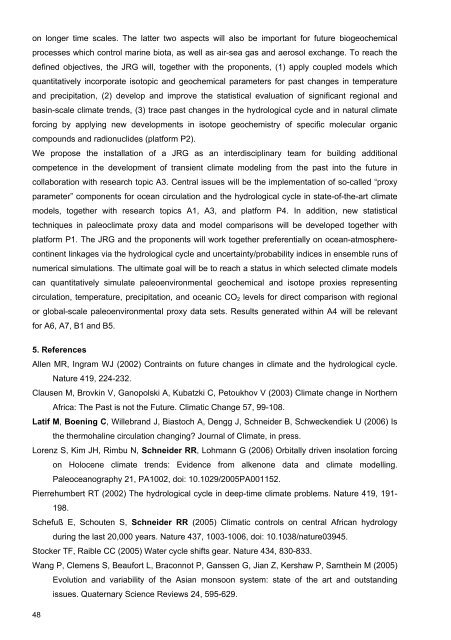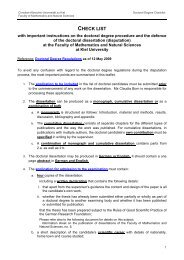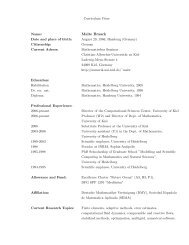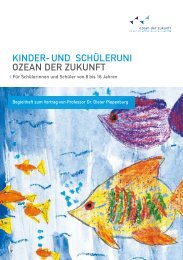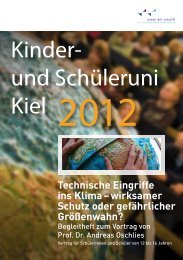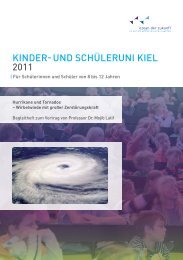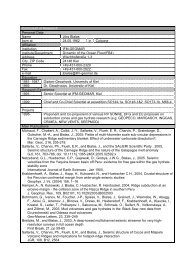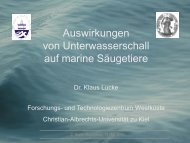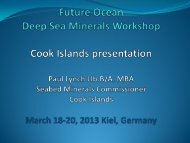Untitled - The Future Ocean
Untitled - The Future Ocean
Untitled - The Future Ocean
- No tags were found...
Create successful ePaper yourself
Turn your PDF publications into a flip-book with our unique Google optimized e-Paper software.
on longer time scales. <strong>The</strong> latter two aspects will also be important for future biogeochemicalprocesses which control marine biota, as well as air-sea gas and aerosol exchange. To reach thedefined objectives, the JRG will, together with the proponents, (1) apply coupled models whichquantitatively incorporate isotopic and geochemical parameters for past changes in temperatureand precipitation, (2) develop and improve the statistical evaluation of significant regional andbasin-scale climate trends, (3) trace past changes in the hydrological cycle and in natural climateforcing by applying new developments in isotope geochemistry of specific molecular organiccompounds and radionuclides (platform P2).We propose the installation of a JRG as an interdisciplinary team for building additionalcompetence in the development of transient climate modeling from the past into the future incollaboration with research topic A3. Central issues will be the implementation of so-called “proxyparameter” components for ocean circulation and the hydrological cycle in state-of-the-art climatemodels, together with research topics A1, A3, and platform P4. In addition, new statisticaltechniques in paleoclimate proxy data and model comparisons will be developed together withplatform P1. <strong>The</strong> JRG and the proponents will work together preferentially on ocean-atmospherecontinentlinkages via the hydrological cycle and uncertainty/probability indices in ensemble runs ofnumerical simulations. <strong>The</strong> ultimate goal will be to reach a status in which selected climate modelscan quantitatively simulate paleoenvironmental geochemical and isotope proxies representingcirculation, temperature, precipitation, and oceanic CO 2 levels for direct comparison with regionalor global-scale paleoenvironmental proxy data sets. Results generated within A4 will be relevantfor A6, A7, B1 and B5.5. ReferencesAllen MR, Ingram WJ (2002) Contraints on future changes in climate and the hydrological cycle.Nature 419, 224-232.Clausen M, Brovkin V, Ganopolski A, Kubatzki C, Petoukhov V (2003) Climate change in NorthernAfrica: <strong>The</strong> Past is not the <strong>Future</strong>. Climatic Change 57, 99-108.Latif M, Boening C, Willebrand J, Biastoch A, Dengg J, Schneider B, Schweckendiek U (2006) Isthe thermohaline circulation changing? Journal of Climate, in press.Lorenz S, Kim JH, Rimbu N, Schneider RR, Lohmann G (2006) Orbitally driven insolation forcingon Holocene climate trends: Evidence from alkenone data and climate modelling.Paleoceanography 21, PA1002, doi: 10.1029/2005PA001152.Pierrehumbert RT (2002) <strong>The</strong> hydrological cycle in deep-time climate problems. Nature 419, 191-198.Schefuß E, Schouten S, Schneider RR (2005) Climatic controls on central African hydrologyduring the last 20,000 years. Nature 437, 1003-1006, doi: 10.1038/nature03945.Stocker TF, Raible CC (2005) Water cycle shifts gear. Nature 434, 830-833.Wang P, Clemens S, Beaufort L, Braconnot P, Ganssen G, Jian Z, Kershaw P, Sarnthein M (2005)Evolution and variability of the Asian monsoon system: state of the art and outstandingissues. Quaternary Science Reviews 24, 595-629.48


